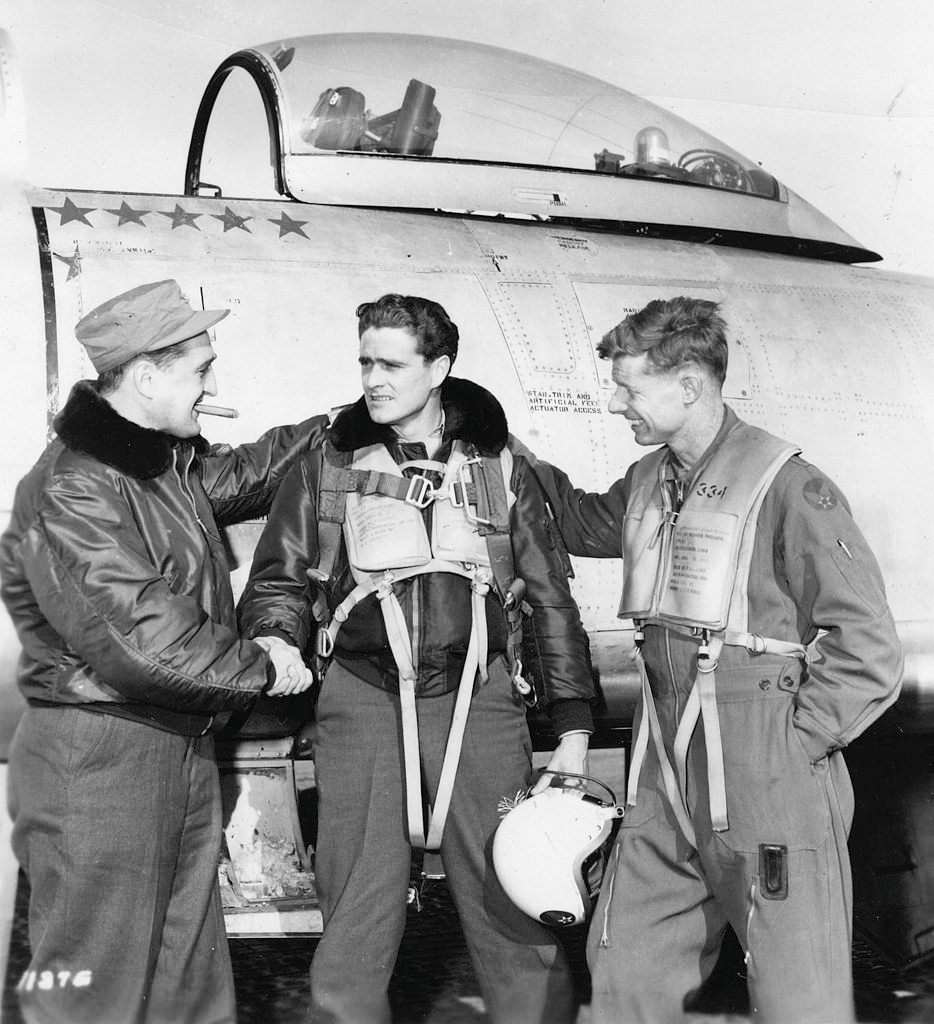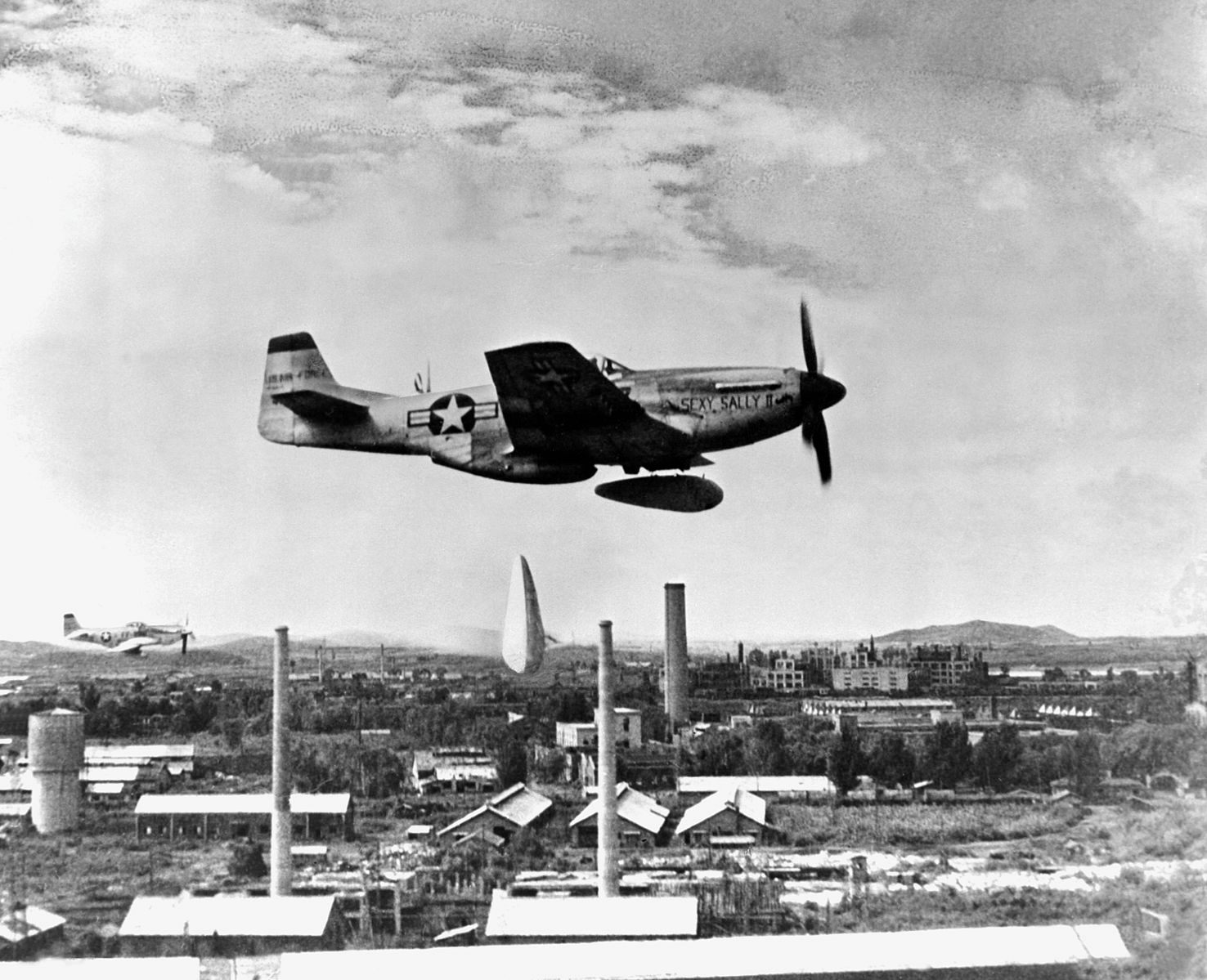The First People to Push the Panic Button Were Korean War Pilots
What started as a last-ditch safety tool became a way for soldiers to make fun of each other.

On March 12th, 1950, a 23-year-old Air Force Lieutenant named William M. Guinther found himself in a tricky situation. He had just flown out of Otis Air Force Base in Falmouth, Massachusetts, and his engine started sputtering. After a few minutes, it died completely.
Luckily, the young pilot thought fast. “Guinther pushed the ‘panic button,’ was ejected, cockpit and all, from the plane, and ‘chuted down onto a cranberry bog,” the Pottstown Mercury reported the next day. “The plane crashed into the sea.”
These days, when someone mashes the panic button, they’re usually acting metaphorically—overreacting, letting emotion trump logic, and generally freaking out. But for a little while, Air Force pilots like Guinther were equipped with actual panic buttons, a last-ditch option during dangerous flights. It’s thanks to their sense of humor that this useful phrase is in the modern lexicon today.
According to a 1956 oral history compiled by Lieutenant James L. Jackson, the first planes equipped with so-called “panic buttons” were B-17s and B-24s used during the Second World War. Under regular conditions, bomber pilots would communicate with their crews via an intercom. But if a plane sustained enough damage to break the intercom, they had a backup system—a set of bells which, sounded in a particular way, meant “prepare to abandon” and then “jump.”
This was the original “panic button,” and it was generally rung instead of pushed.

By the time the U.S. entered the Korean War, in 1950, new planes were in play, equipped with brand new panic possibilities. F-84 Thunderjets had a button that jettisoned the “tip tanks”—extra fuel tanks held on the ends of the wings—in case the plane had trouble flying or taking off. Some models had controls that would shoot extinguishing fluid into a flaming engine, or that would deploy ejector seats like Guinther’s. And almost all planes had “feathering buttons,” which reconfigured the propellers into a more aerodynamic shape in case of engine failure. According to Jackson, all of these were referred to as “panic buttons.”
Sticking a bunch of young men together in a stressful situation is great for slang, and at some point during the war, pilots repurposed the panic button as an opportunity to make fun of their agitated comrades, and then of most wartime situations. “[It is] a joking expression used to cover almost everything,” wrote correspondent H.D. Quigg in 1951. “When an outfit moves, wags will remark, ‘Somebody hit the panic button.’ Some guys in the rear areas even have a well-labeled panic button on the wall by their desks.”
Quigg and other reporters latched onto the free and easy use of this joke as a sign that the fighters were in good spirits. As enemy forces marched towards American camps in the capital, “signs reading ‘panic button’ were shortly found on light switches throughout Seoul,” reported another 1951 article.
“It’s always uttered as broad humor,” Quigg wrote in a different dispatch that same year, adding that its new status as a joke boded well for the troops’ position: “The days of panic are gone,” he wrote. “Experience and confidence have taken over.”

The phrase also began appearing in Air Force slang guides—a popular genre in the 1950s, as people at home became increasingly curious about what, exactly, the soldiers in this relatively new wing of the military were getting up to. In August of 1950, it showed up in The Pegasus, a magazine for aspiring pilots, explained as a “state of emergency when the pilot mentally pushes buttons and switches in all directions.”
Quigg included its jokier definition in his own 1951 lexicon, along with a few other new coinages, including “hassel” [sic] and “no sweat.” The New York Times, behind as usual, stuck it in a 1954 sidebar, called “Jet-Stream of Talk,” right between “hangar rats” and “hawk it.” They defined it as “get excited.” Such a clearly relevant saying quickly made the jump to civilian usage. A New York Times archive search reveals that over the course of the next decade, the metaphorical panic button was either pushed or considered by the television industry, the New York Yankees, and a teen displeased by an unwanted kiss from a sailor.
These days, as the general rate of panic seems to climb higher and higher, real panic buttons still exist—usually as a way to quickly contact police or security companies. But the phrase, with its cooling-down influence, has stuck around as well, working itself into stock tips, sports analysis, and (of course) political discourse. So next time you find your finger inches away from your own personal panic button, thank those feisty Korean War soldiers, who taught us to save the ejecto-seats for when we really need them.



















Follow us on Twitter to get the latest on the world's hidden wonders.
Like us on Facebook to get the latest on the world's hidden wonders.
Follow us on Twitter Like us on Facebook